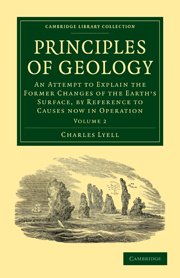 Principles of Geology
Principles of Geology Summary
The theory of the transmutation of species, considered in the last chapter, has met with some degree of favour from many naturalists, from their desire to dispense, as far as possible, with the repeated intervention of a First Cause, as often as geological monuments attest the successive appearance of new races of animals and plants, and the extinction of those pre-existing. But∧ independently of a predisposition to account, if possible, for a series of changes in the organic world, by the regular action of secondary causes, we have seen that many perplexing difficulties present themselves to one who attempts to establish the nature and the reality of the specific character. And if once there appears ground of reasonable doubt, in regard to the constancy of species, the amount of transformation which they are capable of undergoing, may seem to resolve itself into a mere question of the quantity of time assigned to the past duration of animate existence.
Before we enter upon our reasons for rejecting Lamarck's hypothesis, we shall recapitulate, in a few words, the phenomena, and the whole train of thought, by which we conceive it to have been suggested, and which have gained for this and analogous theories, both in ancient and modern times, a considerable number of votaries.
In the first place, the various groups into which plants and animals may be thrown, seem almost invariably, to a beginner, to be so natural, that he is usually convinced at first, as was Linnaeus to the last, “ that genera are as much founded in nature as the species which compose them.”
- Type
- Chapter
- Information
- Principles of GeologyAn Attempt to Explain the Former Changes of the Earth's Surface, by Reference to Causes now in Operation, pp. 18 - 35Publisher: Cambridge University PressPrint publication year: 2009First published in: 1832
